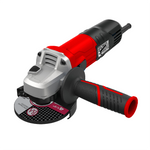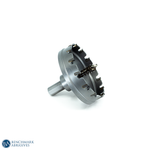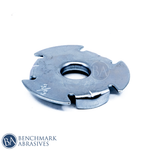
Impact Wrench vs Impact Driver: The Ultimate Guide

Have you ever encountered stubborn bolts or rapid assembly tasks and wondered which power tool would be best for you? Choosing between an impact wrench and an impact driver can make the difference between an easy project and its success or frustrations. Trust me, we've all experienced this situation before. Power tools are the heartbeat of any well-equipped toolbox, especially for DIY enthusiasts who like to tackle their repair or construction projects by themselves.
Power tools such as an impact wrench and an impact driver are truly game-changers for DIY enthusiasts, homeowners, and skilled professionals alike. While they may appear similar at first glance, a closer look at their features and uses reveals some significant differences.
Understanding the Core Differences
The fundamental distinction between impact drivers and impact wrenches lies in their design philosophy and intended applications. While both tools use rotational force combined with impact action, they're engineered for entirely different types of work that homeowners and DIY enthusiasts encounter regularly.
Impact Driver
An impact driver operates as your go-to fastener specialist, combining high speeds with controlled torque delivery. This compact power tool features a 1/4-inch hex collet that accepts drill bits and screwdriver attachments designed specifically for impact applications. When you encounter resistance, the internal hammer mechanism delivers rapid bursts of rotational force, typically producing between 1,500 and 2,000 inch-pounds of torque.
Key components that make impact drivers effective include:
- Motor and hammer mechanism: Creates the rapid impact action that distinguishes these tools from a standard drill
- 1/4-inch hex collet: Provides quick bit changes and compatibility with impact-rated drill bits
- Compact housing: Reduces weight and improves maneuverability in tight spaces
- Variable speed trigger: Allows precise control for different materials and fastener sizes
- LED work light: Illuminates work areas in poorly lit conditions
The beauty of an impact driver lies in its ability to drive smaller screws and medium-sized fasteners without the wrist-twisting kickback you'd experience with a standard drill. Unlike traditional drills, impact drivers excel at maintaining consistent power delivery even when working with stubborn bolts or driving fasteners into dense materials. This makes them invaluable for furniture assembly, where precision matters more than raw power.
Impact Wrench
An impact wrench takes the hammer-and-anvil concept and scales it up dramatically for heavy-duty applications. These robust tools feature a square drive system that accepts sockets, making them perfect for automotive repairs and construction projects involving large bolts. The power output difference is substantial—where impact drivers measure torque in inch-pounds, impact wrenches deliver hundreds to over 1,000 ft-lbs of rotational force.
Essential components that deliver maximum torque include:
- High-torque motor: Generates the power needed for heavy-duty applications and automotive work
- Square drive anvil: Accepts sockets in various sizes (1/4", 3/8", 1/2", 3/4", 1") for different applications
- Impact mechanism: Delivers powerful bursts of rotational force to overcome seized fasteners
- Reinforced housing: Withstands the stress and vibration generated by high-torque operations
- Forward/reverse switch: Allows quick direction changes for loosening and tightening operations
This massive torque advantage makes impact wrenches indispensable for removing lug nuts, working on heavy equipment, and tackling mechanical work that would overwhelm smaller tools. The trade-off comes in size and weight, making them less suitable for tight spaces but perfect when you need enough power to handle the most challenging fastening tasks.

Technical Specifications That Matter
Understanding the mechanical differences helps explain why these tools excel in different applications. The drive type represents perhaps the most noticeable difference between the two tools, affecting everything from attachment options to maximum torque capacity.
Power Output and Torque Delivery
Impact drivers typically deliver between 1,400 to 2,000 in-lbs of torque, making them ideal for driving screws and working with medium-sized fasteners. This torque range provides sufficient power for most DIY projects without overwhelming delicate materials or smaller hardware. The controlled power delivery also means less fatigue during extended use, particularly important for furniture assembly or cabinet installation projects.
Cordless impact wrenches operate in a completely different league, commonly producing 300 to 1,200 foot-pounds of torque. This dramatic increase in power output makes them essential for automotive applications where you might need to remove seized lug nuts or work with large fasteners that have been exposed to the elements. The higher torque also proves valuable in construction projects involving structural connections or heavy-duty construction applications.
Drive Systems and Attachment Options
The hex drive system on impact drivers accepts a wide variety of drill bits and specialized fastening attachments. This 1/4-inch hex collet design allows for quick bit changes and compatibility with impact-rated accessories designed to withstand the tool's rapid hammering action. While you can use a square drive adapter to mount sockets on an impact driver, this approach isn't recommended for high-torque applications where the adapter might fail under stress.
Impact wrenches use square drive systems typically measuring 1/4-inch, 3/8-inch, 1/2-inch, or larger, depending on the tool's intended applications. This socket wrench compatibility makes them perfect for automotive work and mechanical applications where you need to work with nuts and bolts of various sizes. The robust drive system can handle the significant torque loads these tools generate without the safety concerns associated with adapter systems.
Power Source Options for Different Applications
Modern cordless versions of both tools have largely replaced their corded predecessors, thanks to advances in lithium-ion batteries that provide excellent runtime and consistent power delivery throughout the charge cycle.
Cordless Solutions for Maximum Flexibility
A cordless impact wrench offers the perfect combination of power and portability for automotive applications and construction sites where access to compressed air or electrical outlets might be limited. These cordless tools have become increasingly popular among professionals who need to move between different work locations throughout the day. The latest lithium-ion batteries provide enough runtime for most projects while maintaining consistent torque output as the battery discharges.
Cordless impact drivers have become the standard choice for most DIY enthusiasts and professional contractors working on home improvement projects. Their compact size and extended battery life make them ideal for overhead work or projects in tight spaces where maneuverability matters as much as power. Many manufacturers now offer Cordless Impact Driver Kit packages that include multiple batteries and chargers, ensuring you always have power available for your next project.
Pneumatic Impact Wrenches for Professional Applications
Pneumatic impact wrenches remain popular in professional automotive shops and industrial settings where consistent power and durability outweigh portability concerns. These air impact wrench tools connect to compressed air systems, providing unlimited runtime and consistent performance regardless of how long you use them. The power-to-weight ratio of pneumatic tools often exceeds their cordless counterparts, making them the better choice for applications requiring maximum torque output.
The main limitation of pneumatic tools lies in their dependence on air compressor systems and the associated hoses that can limit mobility. However, for fixed work locations like automotive repair shops or manufacturing facilities, these constraints are easily managed in exchange for the superior performance these tools provide.
Choosing the Right Tool for Your Applications
The decision between these power tools ultimately depends on the type of work you regularly perform and the specific challenges you face in your projects.
When Impact Drivers Excel
Impact drivers shine in applications requiring speed and precision rather than maximum torque. They're the best tool for driving deck screws during construction projects, assembling furniture where you need controlled power delivery, and working in small spaces where a larger tool wouldn't fit comfortably. Their compact size and reduced weight make them less fatiguing during extended use, particularly important for overhead work or repetitive fastening tasks.
Even with less torque than an impact wrench, these tools also excel at driving self-tapping screws in sheet metal applications and removing smaller screws that might be seized due to corrosion or thread-locking compounds. The controlled impact action helps prevent cam-out and stripped screw heads, common problems when using a standard drill for these applications. For most homeowners tackling typical DIY projects, an impact driver provides the perfect balance of power and control.
For most homeowners tackling typical DIY projects, an impact driver provides the perfect balance of power and control.
When Impact Wrenches Are Essential
Impact wrenches become essential when you need to generate significant torque for automotive repairs, heavy-duty construction, or mechanical work involving large fasteners. Removing lug nuts represents the classic application where no other tool can match an impact wrench's efficiency and speed. The high torque output also makes these tools invaluable for working on lawn mowers, small engines, and heavy equipment where fasteners might be severely corroded or over-tightened.
Construction applications involving lag bolts, structural connections, and large machinery assembly all benefit from the superior torque capacity that impact wrenches provide. While you could theoretically accomplish some of these tasks with manual tools or other power tools, the time and effort savings make impact wrenches indispensable for professional contractors and serious DIY enthusiasts.
Making Your Selection
For most homeowners focused on typical home improvement projects, an impact driver offers the versatility and power needed for the majority of fastening tasks you'll encounter. Its compact size, moderate power output, and precision make it the better choice for furniture assembly, cabinet installation, and general maintenance work around the house.
Professional mechanics and contractors working on automotive applications or heavy-duty construction will find an impact wrench essential for their daily work. The superior torque output and socket compatibility make it irreplaceable for applications involving large bolts, seized fasteners, and time-sensitive repairs where efficiency matters as much as results.
Pro Tips for Maximum Performance
Getting the most from your power tools requires understanding their capabilities and limitations, regardless of whether you choose an impact driver or impact wrench for your specific applications.
Impact Driver Best Practices:
- Use impact-rated accessories: Standard drill bits can shatter under the rapid hammering action
- Start slowly: Begin with light trigger pressure to seat fasteners properly before increasing speed
- Apply steady pressure: Let the tool do the work rather than forcing it through resistance
- Listen for changes: The sound will change when fasteners are properly seated to prevent over-driving
Impact Wrench Best Practices:
- Match socket size precisely: Properly fitting sockets prevent rounding of bolt heads and extend tool life
- Use short bursts for tightening: Avoid over-torquing by applying power in controlled intervals
- Maintain proper alignment: Keep the tool and socket square to the fastener to prevent slippage
- Consider a torque wrench for final tightening: Critical applications may require precise torque specifications
Many experienced users eventually acquire both tools, recognizing that each serves different purposes in a complete workshop setup. The impact driver handles precision work and general fastening tasks, while the impact wrench tackles the heavy-duty applications that require maximum torque and speed. This combination provides the flexibility to handle virtually any fastening challenge you might encounter, from delicate furniture assembly to major automotive repairs.
Understanding the key differences between an impact driver vs impact wrench allows you to select the appropriate tool for your specific needs, leading to better results and less frustration on every project you undertake. If you have any questions, feel free to contact Benchmark Abrasives.



































































